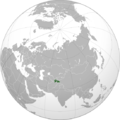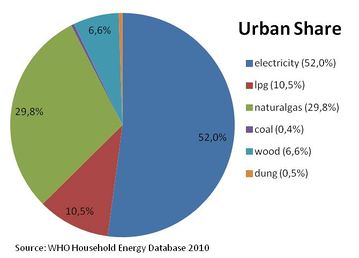Difference between revisions of "Tajikistan Energy Situation"
***** (***** | *****) m |
***** (***** | *****) m |
||
| Line 2: | Line 2: | ||
|CES Country Name=Tajikistan | |CES Country Name=Tajikistan | ||
|CES Country Capital=Dushanbe | |CES Country Capital=Dushanbe | ||
| − | |CES Country Region=Europe & Central Asia | + | |CES Country Region Europe and Central Asia = Europe & Central Asia |
|CES Country Coordinates=38.5500° N, 68.8000° E | |CES Country Coordinates=38.5500° N, 68.8000° E | ||
}} | }} | ||
| Line 68: | Line 68: | ||
[[Tajikistan Energy Situation#toc|►Go to Top]] | [[Tajikistan Energy Situation#toc|►Go to Top]] | ||
| + | [[Category:Tajikistan]] | ||
[[Category:Europe_and_Central_Asia]] | [[Category:Europe_and_Central_Asia]] | ||
| − | |||
Latest revision as of 21:27, 10 July 2018
Capital:
Dushanbe
Region:
Coordinates:
38.5500° N, 68.8000° E
Total Area (km²): It includes a country's total area, including areas under inland bodies of water and some coastal waterways.
141,379
Population: It is based on the de facto definition of population, which counts all residents regardless of legal status or citizenship--except for refugees not permanently settled in the country of asylum, who are generally considered part of the population of their country of origin.
9,952,787 (2022)
Rural Population (% of total population): It refers to people living in rural areas as defined by national statistical offices. It is calculated as the difference between total population and urban population.
72 (2022)
GDP (current US$): It is the sum of gross value added by all resident producers in the economy plus any product taxes and minus any subsidies not included in the value of the products. It is calculated without making deductions for depreciation of fabricated assets or for depletion and degradation of natural resources.
10,492,123,388 (2022)
GDP Per Capita (current US$): It is gross domestic product divided by midyear population
1,054.19 (2022)
Access to Electricity (% of population): It is the percentage of population with access to electricity.
99.57 (2021)
Energy Imports Net (% of energy use): It is estimated as energy use less production, both measured in oil equivalents. A negative value indicates that the country is a net exporter. Energy use refers to use of primary energy before transformation to other end-use fuels, which is equal to indigenous production plus imports and stock changes, minus exports and fuels supplied to ships and aircraft engaged in international transport.
36.25 (2014)
Fossil Fuel Energy Consumption (% of total): It comprises coal, oil, petroleum, and natural gas products.
45.98 (2014)
Introduction
Tajikistan is Central Asia's smallest country. It is landlocked and lies in an active seismic zone with frequent earthquakes. Mountains and territory over 3000m high covers 93% of its area, with the the Pamir and Alay Mountains dominating the landscape.[1]Tajikistan's climate is continental with seasonal variations. It has hot summers and mild winters and a semiarid to polar climate in Pamir Mountains. The average low and high temperatures are 8.1°C and 22.0 °C, respectively. [1]2.9% of the land in Tajikistan is covered by forest. The forest annual rate of change (between 2005-2010) was 0% [2]
Tajikistan has a population of 7.6 million, the majority of which (74%), lives in rural areas. The population density is 48 Persons per km² . Tajikistan is the poorest country in Central Asia and its economy remains fragile due to corruption, weak governance, unemployment, and seasonal power shortages. More than 40% of the populations lives under the poverty line of 2 USD/day. Yet recent years have seen an annual economic growth rate of 8-10%. The GDP in 2010 was $US 5.6 billion and GDP per capita was $US 820. Its economy is based on the production of hydro power, cotton, and aluminum and national income sources consist primarily of agriculture (49.8%), services (37.4%), and industry (12.8%). [1]
Energy Situation
After the end of the Soviet Union, electricity subsidies were terminated and the following energy demand gap was predominantly filled by local biomass resources, such as coal and wood, resulting in increased deforestation and pollution. In certain areas, the average electricity available amounts to less than 4 hours daily during winter.
Tajikistan has enormous hydro power potential as it possesses 4% of the world's hydro power resources and 53% of Central Asia's resources. Yet these resources remain to be sufficiently developed. About 94% of electricity generating capacity is hydroelectric, but only an estimated 5% of its potential is in use. The country faces an energy deficit of 3.0 to 3.5 GWh, resulting in regular blackouts from October to April. Primary energy shares in 2008 consisted of the following: 21.6% oil, 18.3% gas, 56.4% hydro, and coal 3.7%.
The electrification rate is 85.4 [3]. Hydro-electricelectricity generates around 17,00GWh per year. Prices vary but people typically pay 1.5 US cents/kWh. The TajikAluminum Company (TALCO), is the largest consumer in Tajikistan and uses about 50% of total electricity consumption.
Many components of the transmission and distribution system are in bad condition and need to be replaced. Network and commerical losses result in up to 17'% losses. Rural populations experience more difficulties in accessing electric power due to bad conditions of the system, instability of voltage, and high losses.
Potential for Renewable Energies:
Since electricity prices are very low due to low prime costs for the large hydro plants, alternative ways to generate electricity have been limited. However, Tajikistan's rivers have great hydropower potential and thus the government has focused on attracting investments for projects for internal use and electricity exports. [4] Furthermore, hydro-power is the only RE source for electricity production on national level, whose input is documented. [5] In addition, recent surveys (see Tajikistan household survey 2012) have confirmed a large interest, especially among the rural population to install solar power in order to decrease energy dependence and some micro-finance institutions have already begun to develop credit lines in order to enable the purchase of solar systems.
The estimated solar potential is about 25 billion kWh/year in Tajikistan. There are about 2,100 to 3,000 hours of solar energy per year. While this potential has not yet been exploited, Tajikistan does utilize some solar resources for water heating purposes.[6]
Household Energy Situation
Share of energy types on cooking energy in urban and rural areas of Tajikistan.[7]
Percentage of population using solid fuels (charcoal, coal, cropwaste, dung and wood) as cooking energy.
National: 21.5%, urban:<5%, rural: 34.5% [7]
The share of solid fuels in Tajikistan is in no way homogenous, as we find wood to be the primary fuel biomass in the Pamirs region and coal imported from Usbekistan to be the primary source in the Northern part of the country (Sughd region).
The average electricity available in rural areas of Northern Tajikistan (Sughd Region) amounts to less than 4 hours daily during the 5 months of winter. An average rural/farming household (7 persons) will use approximately 4 tons of coal during these 5 months, while heating a single room only, representing a major financial constraint for many families.
Impact of solid fuel on health
- Total annual deaths attributable to solid fuel use: 1600 persons
- Percentage of national burden of diseases attributable to solid fuel use: 3.5%[8]
Further Information
References
- ↑ 1.0 1.1 1.2 CIA - The World Factbook
- ↑ FAO (2011): The State of the World's Forest
- ↑ http://www.ngdc.noaa.gov/dmsp/pubs/Elvidge_WINTD_20091022.pdf
- ↑ INOGATE Energy Portal
- ↑ http://www.iea.org/stats/renewdata.asp?COUNTRY_CODE=KG
- ↑ INOGATE Energy Portal
- ↑ 7.0 7.1 WHO 2010: WHO Household Energy Database
- ↑ WHO (2006): Fuel for Life - Household Energy and Health























